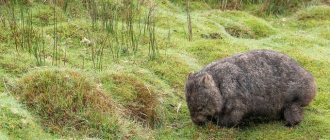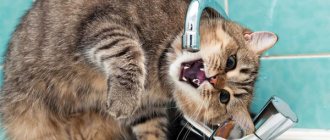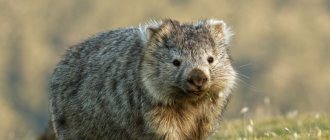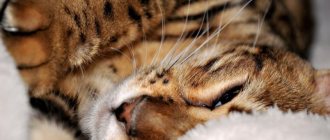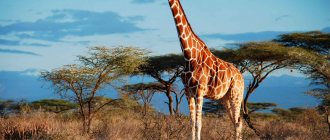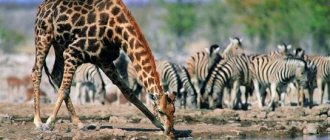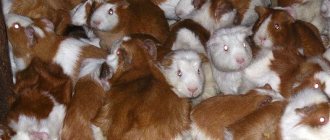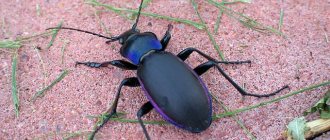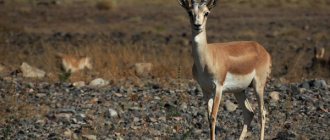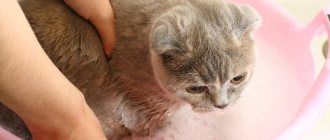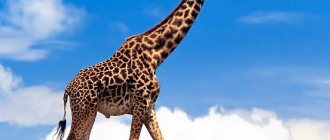Since ancient times, poets of the East have used the name of this animal, praising maiden beauty. The gazelle is a beautiful, slender and graceful animal, so it is not surprising that it is often mentioned in literature.
But the gazelle is of interest not only to fans of the literary word, but also to nature lovers. Our article will tell you how these amazing animals live in the wild.
Description
Dorcas gazelles are generally similar in appearance to the common gazelle, but are smaller in size. Their ears are longer and their horns are more curved. The horns of males are 250-280 mm long, and the number of rings on them is from 20 to 24. The horns of the female are smaller (170-190 mm), and there are 16-18 rings. Adult males weigh on average 16.5 kg, while females weigh 12.6 kg. Depending on the location, the color of the Dorcas Gazelle varies. Most of the body is covered with sandy-colored fur, the underbelly is white, and there are two brown stripes on the sides. In the northern Sahara, the coat color of Dorcas gazelles is golden with darker stripes on the sides. Near the Red Sea, the coat color is reddish-brown with faint side stripes. The head is darker than the rest of the body.
Characteristic signs
The largest gazelle reaches a height of 110 cm, the smallest - up to 50 cm. Both sexes wear horns. Females are slightly larger than males and have a more rounded chest structure. If you look, the photo of the animal fascinates with its grace, combination of lines and proportions. The dense red fur has a clear border between fawn on the back and white on the belly.
In the East, the animal gazelle was described in many treatises on poetry. Hunting for artiodactyls was equated with the best forms of recreation. When jumping, the animal's body extends in an even arc. As you run, the muscles roll, creating a colorful visual effect.
Thanks to paintings dedicated to this topic, we can judge what the gazelle animal looked like in the past. This species was formed so perfectly that it did not change its morphological structure. The appearance in the 10th–15th centuries was the same as it is now.
Natural habitat
The Dorcas gazelle is one of the most adapted animals for life in the desert. Gazelles are found in a variety of places: savannas, semi-deserts, small fields of sand dunes, where various types of plants are present. Dorcas gazelles can live their entire lives without drinking water, as they obtain all the necessary liquid from the plants included in their diet. However, they will drink water if it is available. This species is able to live at very high ambient temperatures, but in extreme heat, they are active mainly at dawn, evening and night. In areas where Dorcas gazelles are persecuted, they are active at night to minimize the risk of attacks. Under difficult conditions, gazelles live in pairs, and under favorable conditions, they are found in family herds with one adult dominant male, several females and cubs.
Spread of Grant's Gazelle
Grant's gazelle is common in the east of the African continent, living mainly on open plains, among low thorny bushes, and on wooded savannas. On the contrary, it avoids regions with high grass cover, since it cannot see predators there. It is less common in semi-desert areas, as it is able to adapt to arid conditions. This is a migratory animal, but it does not travel like other ungulates, for example, Thompson's gazelle, zebra and wildebeest, which migrate in search of water, but is guided by the availability of food in a particular region. Grant's gazelle survives on vegetation even in arid, semi-desert areas. At the same time, there is practically no competition for food in such areas.
Reproduction
The mating season lasts from September to November. During this time, males guard the territory and mark it with their own excrement. Depending on the local climate, a group of Dorcas gazelles will consist of one or two males, with a harem of females, or just a male and female pair. In extreme climatic conditions, with limited resources, gazelles primarily create pairs. The mating system of Dorcas gazelles is polygynous.
In the wild, females are ready to breed at two years of age. In captivity, pregnancy can occur as early as six months of age. About 90% of females in the wild become pregnant. In almost all cases, one young is born per litter. Gestation lasts about six months and the baby is born covered in fur and with open eyes. The offspring spends the first weeks of life hidden in the shadows. After this, they begin to follow their mother and look for solid food. Males do not participate in raising the young.
Females nurse their offspring for one to two minutes, several times a day, for about 3 months. During the first two weeks of the baby's life, the mother gazelle grazes and sleeps far from it, but leaves it in a relatively safe place. As they grow, young gazelles join their group.
What does artiodactyl eat?
According to the classification, gazelles are animals from the genus of herbivores. But even among their fellows, they stand out for their food preferences. The stomach of the wild gazelle is 2.5 m longer than that of other artiodactyls. They choose grass and leaves with medium fiber hardness. Preference is given to plants with a high content of essential oils, vitamins and proteins.
The nature of the diet is reflected in how the gazelle looks. Slim body, harmoniously formed muscles. Almost all breeds have toned, strong hips and a streamlined body. Antelope is a gazelle, included in Eastern tales as the fastest animal. Among them, in first place is Dorcas, whose photo was featured in Life magazine in 1982.
The difference is the amount of food needed. Thompson's gazelles living in Africa eat up to 30 kilograms of grass per day. On the contrary, the gazelle antelope from Azerbaijan is content with 10 kilograms.
Nutrition
Dorcas gazelles feed on the flowers, leaves and pods of acacia trees in many habitats. Fruits, leaves and various shrubs are also consumed. In the Negev Desert, Dorcas gazelles feed on the Pancratium sickenbergeri plant. Depending on the season, the methods of obtaining food change. In summer, gazelles dig holes in the sand to obtain the stems and bulbs of Pancratium sieckenberger. After winter rains, Dorcas gazelles eat freshly sprouted leaves. Methods of obtaining food ensure maximum energy consumption with minimal effort.
Interesting facts about Grant's gazelle
- Grant's gazelle still remains a widespread species, although in some regions of its habitat it has been completely destroyed. The main threat to the species was the destruction of its natural habitat and hunting. The species is protected and monitored in national parks and reserves, for example, in the Serengeti National Park and Ngorongoro Game Reserve in Tanzania, Lake Turkana National Reserve and the Maasai Mara Game Reserve in Kenya. The population size, according to various estimates, ranges from 140,000 to 350,000 individuals. Some areas have stable populations, but overall there is a decline in animal numbers.
Behavior
Gazelles have a distinctive alarm call that sounds like a short bark and use a louder call in cases of extreme danger or pain. Females have a low grunt, with which they call their cubs and other individuals of the subspecies. If danger comes from a predator, Dorcas gazelles may make a long growling sound to signal danger.
Population and species status
Photo: Jeyran
A few centuries ago, the goitered gazelle population was very numerous in the vast semi-desert and desert regions of many states. Even daily hunting by local residents could not significantly affect its numbers. Antelopes fed humans with delicious meat (up to 15 kg per goitered gazelle) and provided them with the strongest skin, but man’s unbridled passion for profit led to the fact that these mammals began to be exterminated at lightning speed and on a huge scale. With the help of cars, people learned to drive herds of antelope into traps, blinding the animals with bright headlights, then carried out mass executions of artiodactyls, the picture of which was simply terrifying.
There is evidence that by the beginning of the 2000s the goitered gazelle population was about 140 thousand animals, but according to statistics from recent decades, the rate of its decrease has increased by another third, which cannot but worry. Nowadays you can hardly find gazelles in Azerbaijan and Turkey. In the vastness of Kazakhstan and Turkmenistan, the number of their livestock has fallen tens of times.
The main threat and reason for the plight of these artiodactyls is the thoughtless and selfish activities of people, which affect the animals not only directly (poachers), but indirectly (reduction of places of residence due to plowing of land and the creation of pastures). Due to this alarming situation regarding numbers, a number of conservation measures have been taken to revive the population of these amazing gazelles, which are currently classified as a vulnerable species.
Predation
The Dorcas gazelle population is preyed upon by many predators. Cheetahs, lions, servals, wolves, caracals, and hyenas attack gazelles, regardless of the size and age of the animal. The young may be killed by smaller predators such as foxes, eagles, and jackals. Many of these predators have been wiped out in areas where gazelles currently live. Humans, wolves and lynxes continue to be the main threats to Dorcas gazelles. To observe predators, gazelles use keen vision.
Enemies
The gazelle is an animal with well-developed vision and hearing. At the slightest rustle or noise, she suddenly takes off. At the same time, the speed it develops reaches sixty-five kilometers per hour. Sometimes the animal stops, checking whether the threat was mistaken. Often such checks end in failure. The predator does not miss his chance.
The main method of escape from enemies is jumping to the side and running in a zigzag. And gazelles have many enemies. These are terrestrial predators - leopards, cheetahs and lions, as well as birds - eagles, golden eagles, imperial eagle and vultures.
Van GAZ-3302
There are such models of GAZelle vans:
- This GAZ 330232 Farmer type car has a clad metal body with an area of 10.5 m². The vehicle can carry loads up to 1.3 tons. The seats are made in 2 rows and can accommodate 5 people. The body is solid. It perfectly protects the cargo from the outside and inside, and reduces temperature changes. It is convenient to load goods or things through the rear gate, which has a 270-degree rotation. In an isothermal van, the body walls are insulated. To do this, use 5 cm foam. The inside of the body is upholstered with food-grade galvanization. This helps maintain a stable temperature inside and, in addition to things, transport food.
- The body of this Gazelle GAZ-3302 van is made of sandwich panels. In it, businessmen transport products that require a certain temperature regime to order for private owners or from warehouses to stores. Excellent thermal insulation of sandwich panels is achieved due to the presence of 5 or 10 cm of polyurethane foam in them. How thick will it be? It depends on the equipment of the car. Most often, such cars are equipped with refrigeration units. The interior walls are lined with galvanized metal. The van can carry goods and things up to 1 ton. The useful area of the short wheelbase is 10 m³, and the length is 17 m³. The internal lining of the body walls is made of galvanized metal.
- GAZelle GAZ-3302 - this van is isothermal. It is ordered for short-distance transportation of flowers, food, medicines and other goods that require a certain temperature regime. 2 people can ride in the cabin with the driver. This model has heated mirrors and power steering. The body is panel-frame. It is 10 m³. Panels are attached to the frame outside. They are metal (clad). The inside of the body is lined with galvanized steel sheets. This car can carry loads up to 1.5 tons.
- GAZ-3302 is a manufactured goods van. Most often, such a car is ordered to transport things. There is no specific temperature regime inside the cargo compartment. The cabin has 2 seats for passengers. There is 13 m³ of space in the body that can be put to good use. /With an extended base, there will be more usable area. This vehicle can transport loads up to 1.5 tons. The platform is 1 m high and the cargo compartment is 2 m. This means that this vehicle can transport tall goods and things. The body has metal-plastic panels. They perfectly protect cargo from condensation, rain, snow, and wind.
Now you will find out the most popular Gazelles models among private owners and businessmen, which are used to transport a variety of cargo. Based on the above information, order for moving, transporting goods, or buy the GAZelle that is suitable.
Pets of the African plains: zebras, topi antelopes and Thomson's gazelles. Video (00:51:30)
An amazingly touching program that tells about the development of young wild animals of different species, from birth to their achievement of independence. Big cats, primates, large ungulates and marsupials, mammals of tropical jungles, African savannas and European forests, and even whales - with love and compassion for their characters, the authors will tell us how they are born, how they grow and develop, mastering the necessary things for survival skills surrounded by the tender care of parents. Using rich, stunningly beautiful video material, replete with touching, often funny, and sometimes tragic scenes from the lives of offspring and their parents, the creators of the series narrate the amazingly emotional process of growing up of new generations of wild animals belonging to different breeds, full of joy, tenderness, games and dangers. species, different ecosystems, and leading often radically different lifestyles.
Educational resource about culture, science and art
Author of the article: Sergey Kuriy Category: “Cultural zoology”
In the world of physics there are particles and antiparticles, in the world of literature there are heroes and antiheroes. But in the world of zoology there are only antelopes and no “lops” are observed there. On this occasion, there was even a joke - that, supposedly, “an anti-lopa is a woman on a diet” (in another version - “a very durable balloon”).
“And in each eye there is a gazelle...”
In fact, there is no negative particle in the name of these artiodactyls. The letter “and” appeared there purely by chance, because the original – Greek – name sounded like “antholops”. It is believed to have come from a combination of two other Greek words, anthos (flower) and ops (eye), which together meant “beautiful eye.”
Illustration from The History of Four-Footed Beasts (1607). Edward Topsell.
However, for the Russian ear the word “antelope” still does not sound very nice (funny rhymes like “stupid” or “butt” immediately come to mind). Another thing is the melodious word “gazelle”. It comes from the Arabic “ghazal”, which had several meanings: 1) a small antelope; 2) courting women; 3) a type of poetic stanza in Arabic poetry; 4) spinning.
The first three values turned out to be inextricably linked. Arabs have long admired both the gracefulness of the gazelle and its huge shiny black eyes with long eyelashes. Therefore, in Arabic poetry, this animal has long become a stable metaphor for describing a beautiful woman.
Nizami “Leili and Majnun” (1188):
...An instant glance, a glancing glance of hers Was like an arrow striking the tip.
The gazelle, with innocent timidity in the eyes of the Lords of the earth, plunged into dust...
Apparently, this tradition developed in the pre-Islamic era.
Antara ibn Shaddad (5th century Arab poet):
...I looked through the eyes of a strengthened baby gazelle - beautiful, like those that are born without twins.
... She turned around, and the neck was like a baby gazelle, one of those slender ones, and their noses were spotted with white.
Also well known in the Arab world is the story of Caliph Abdul-Malik (646–705), who released a gazelle because it reminded him of his beloved Leila. The comparison of beauties with gazelles migrated into Russian poetry.
Sasha Cherny “My novel”:
The fireplace cactus is pulling its thorns towards us, And the teapot is grumbling like a bumblebee... Lisa has wonderful warm hands And there is a gazelle in each eye...
Nikolay Gumilyov, “Hoku”:
Here is a girl with gazelle eyes Marrying an American. Why did Columbus discover America?!
Gazelle lady.
As mentioned above, in Arabic poetry there is a whole poetic stanza, which is called “ghazal”. In form, it consists of a series of couplets - and the lines of the first couplet rhyme with each other (aa), and in subsequent couplets this rhyme is repeated in only one of the lines (ba, ca, da, etc.). As for the content, the “ghazal” is usually dedicated to unrequited love and longing for love. As an example, I will give excerpts from the poems of the famous 14th century Persian poet Hafiz Shirazi.
*** When I choose the beautiful Shiraz as my idol, I will give both Samarkand and Bukhara for her birthmark.
Pour me a full cup, dear one! In heaven I will not be given the Gardens in the vicinity of Shiraz and the babbling of the river in the morning!
Confusing, a crowd of mischievous dark-skinned girls stole our minds: This is how troops of Turks at a feast steal treats.
Why does the beautiful beloved need my insignificant love? Does beauty need blush? She will reject tinsel!...
*** Hafez is killed. And what killed him - Your black eye, child, you should ask.
Cruel black! (i.e. black eye - approx.) How he shoots with arrows! Wherever he throws them, there is a grave...
Gazelle on a Byzantine era mosaic.
Relatives, but not that much.
But let's return to our ungulates. On the one hand, it would seem that everything is clear: gazelles are the same antelopes - only, as a rule, they are not very large and slender. However, from the point of view of zoological systematics, the situation is not so simple. Yes, all antelopes and gazelles are related and belong to the bovid family along with goats, rams and bulls. Bovids differ from the same deer in that their antlers do not branch or shed (the bone rods are firmly attached to the frontal bones).
Common gazelles.
On the other hand, antelopes and gazelles are so diverse and heterogeneous that scientists do not have the right to place them in one subfamily. Indeed, for modern zoological taxonomy, the main thing is not external similarity, but genetic and genealogical similarity. As a result, the impala, which is very similar to a gazelle, was eventually moved into a separate subfamily, which is also closer to the long-faced cow antelopes than to gazelles. Moreover, some species of antelope are generally included in the same subfamily with... bulls. It turns out that, in fact, those whom we call antelopes and gazelles are actually a composite group, scattered across several different taxa.
“Oh, I’ll give it a ride!”
Personally, I associated antelopes and gazelles not so much with female beauty, but with rapid running. I even dare to say that these are the fastest animals on the entire earth’s land. In fairness. Yes, promoted wherever possible, the cheetah really is a record holder, capable of reaching speeds of up to 120 km/h. But only in a jerk and not for long. If the predator does not have time to overtake the prey in the next few seconds, then it quickly runs out of steam and simply cannot pursue it further.
It's different - gazelles and antelopes! For example, the Mongolian gazelle gazelle can run 12-15 km without a break, maintaining the speed of a passenger train (60-65 km/h). At this rate, the cheetah would have had a heart attack long ago. Saigas run even faster, reaching speeds of up to 70-80 km/h.
A gazelle plays senet with a lion (fragment of a satirical papyrus. Ancient Egypt, c. 1150 BC).
The running of antelopes is not only swift, but also beautiful and light. The frightened herd of impalas literally scatters in different directions like grasshoppers. When running, these animals hover in the air, making huge jumps up to three meters high and up to 10 meters long.
Impala in a jump.
It’s hard to believe, but I read that even such heavy and large antelopes as elands (up to one and a half meters at the withers and weighing 500 kg) are capable of jumping over each other!
Many gazelles and antelopes are also characterized by specific jumps, which are called “candles.” Sensing danger, the animal sharply pushes off the ground and flies vertically upward like a spring. This habit is directly evidenced by the name of one of the types of gazelles - springbok (from the English spring - spring).
Springbok makes a "candle".
I. Ilf, E. Petrov “Golden Calf”: “- Adam! - he shouted, covering the grinding of the engine. — What is the name of your cart? “Lauren-Dietrich,” answered Kozlevich. - Well, what kind of name is this? A machine, like a warship, must have its own name. Your "Lorenditrich" is distinguished by its remarkable speed and noble beauty of lines. Therefore, I propose to give the car a name - “Antelope-Wildebeest”. Who's against it? Unanimously".
Antilope names were also awarded to real car brands. Let us recall, for example, the American Chevrolet Impala, which the Winchester brothers drive around in the TV series Supernatural, or the Russian Gazelle. During the Soviet era, there were also landing boats “Jeyran” (this is the name of a type of Central Asian gazelle).
Anecdote: “Now they showed a channel about animals - a tiger tracked a gazelle, caught it and ate it! “And how many passengers were there in the Gazelle?”
Chevrolet Impala and Gazelle cars.
Gazelles are long-nosed and bipedal
As I wrote above, the diversity of antelopes and gazelles is extremely large. Therefore, it’s time to look at individual species in more detail. I warn you right away - I am not going to talk about ALL representatives of this vast group of artiodactyls. Firstly, a detailed summary will seem boring to the average reader, and secondly, there are encyclopedias and other specialized publications for this. I will try to highlight the brightest and most interesting...
We'll start with gazelles and their closest relatives, which zoologists group into the subfamily of true antelopes. As I wrote earlier, in the minds of people, gazelles have always been a symbol of beauty and grace. But even in this “family” there was a “freak”.
Skull and head of a saiga.
We are talking about an inhabitant of the Central Asian steppes and semi-deserts - the saiga (sometimes called simply “saiga”). To some, the saiga may resemble an ugly goat due to its large, hook-nosed muzzle with an overhanging proboscis. However, nature doesn’t give a damn about human canons of beauty. The main thing is expediency. The fact is that the saiga lives in a not very pleasant climate zone - with large temperature differences. In the same Kazakh steppes, winter temperatures can drop to -40 degrees. This is where the huge nasal cavities come in handy, capable of warming the inhaled icy air. Well, in the hot summer, the noses of saigas play the role of gas masks, filtering the dust raised when running.
By the way, the idea of the saiga as an inhabitant of sandy deserts is false. His hooves are not suitable for walking on sand; he even tries not to go into arable land because of the loose soil.
Saiga.
Interestingly, back in the 17th century, the range of saigas extended from the foothills of the Carpathians in the west to Mongolia in the east and Southern Siberia in the north. Plowing of land and active hunting narrowed the range to the borders of Central Asia. If the Soviet government had not issued a decree in 1919 banning the hunting of saigas, perhaps this species could have become extinct. When the population of Kazakh saigas alone reached 1 million individuals, the authorities even allowed them to be shot - of course, to control their numbers. They say that this is precisely why the famous carbine with the self-explanatory name “Saiga” was developed.
Of course, poaching existed in Soviet times, but after the collapse of the USSR it acquired an uncontrollable scale. The “Achilles heel” of the saiga was its curved translucent horns with rings. The fact is that they are highly valued in traditional Chinese medicine - either as an aphrodisiac or as a remedy for stroke. And so, in 2002, the IUCN again declared the saiga a species “in critical condition” (by that time only 20 thousand individuals remained in Kazakhstan). In 2005, shooting was banned again, and today the number of Kakakh saigas has exceeded 250 thousand.
Ch. Ai: “People, people are man-gods! ...First they appeared on horses, dressed in skins, armed with arrows, then they appeared with banging guns, whooping, galloping back and forth, and the saigas rushed in a crowd in one direction, in the other - go and find them in the saxaul tracts, but the time has come, and the man-gods began to organize raids in cars, starving them to death, just like wolves, and felled the saigas, shooting them on the move, and then the man-gods began to fly in helicopters and, having first looked at the saiga herds in the steppe from the air, went to surround the animals at the indicated coordinates, while ground snipers rushed across the plains at speeds of up to a hundred kilometers or more so that the saigas did not have time to hide, and helicopters adjusted the target and movement from above.”
Baby saiga.
Gazelles living in African savannas are luckier. Species such as the springbok, Thompson's gazelle and Grant's gazelle are still among the most abundant ungulates of this continent. What can we say about the 19th century, when a migrating herd of springbok could stretch 25 km wide and 230 km long! In 1853, the German doctor E. Kretschmar even mentioned how a similar herd trampled to death a local resident who stood in its way.
Springbok and Thompson's gazelles.
By the way, remember the comic song by Vladimir Vysotsky about how “one giraffe fell in love with an antelope”? So, the so-called giraffe gazelle or gerenuk actually lives in Africa. Among its relatives, the gerenuk stands out for its highly elongated neck and high stilt-like legs. But even this seemed to him not enough. In an attempt to reach the highest branches and leaves, the gerenuk learned to balance on two legs. Stretching out in a column, it can reach a height of 2.5 m, which other gazelles are not able to reach.
Gerenuk.
If Europeans compared the gerenuk to a giraffe, then the Somalis considered it a direct relative of the camel. Such a performance only benefited the gerenuk - local residents are afraid to kill it, because they believe that this will lead to the death of camels.
Forest babies
It must be said that not all antelopes form herds and run around in open space. Among them there are also very secretive and unsociable species. For example, it is extremely difficult to see a dwarf antelope in nature. She lives in forest thickets, is active only in the dark and is very small (only 25 cm at the shoulders). Her hind legs are longer than her front ones, so from a distance it is easy to confuse her with a hare.
Dwarf antelope.
A little larger (30-35 cm) is another antelope with the funny name “dik-dik” (this is an imitation of its cry). The dik-dik looks very funny - on its muzzle there is an elongated proboscis, and on its head there is a crest from which small horns protrude.
Dik-dik.
The duiker also has a crest, but the horns are so small that they are almost completely hidden in this crest. The duiker himself also knows how to masterfully hide, literally diving into dense thickets (for which he received his name, which means “diver” in Afrikaans). The size of the duiker is also small. The smallest species are the size of a hare, the largest are no larger than a roe deer. The diet of duikers is not limited to plant foods - on occasion, they can eat carrion, rodents and birds, and they have a special passion for ants.
Black duiker.
Due to their secretive lifestyle, duikers, dik-diks and pygmy antelopes are strict monogamists. They form pairs for life, and they strongly dislike relatives of the same sex (damned homophobes!). Moreover, the male duiker takes care of the offspring equally with the female, and as new offspring appear, their older brothers and sisters join in the care. Finally, it is worth saying that duikers do not belong to real antelopes and are classified as a separate subfamily.
Saber-horned antelope
The external appearance of the third subfamily of antelopes is already indicated by its name - saber-horns. Unlike the forest “babies”, these are beautiful, large and strong ungulates with long horns. For example, the horse antelope (which got its name from its stiff, erect mane on its thick neck) reaches 160 cm at the withers, and its head is decorated with horns up to 90 cm long, curved like sabers.
Horse antelope.
The oryx has even longer horns - up to 120 cm. They are sharp and straight, like a rapier, and are able to protect the antelope even from a lion. But in mating fights, Oribi males use their weapons extremely carefully - they simply fence and whip with their horns. The ritual reached such a degree of automatism that one day they saw how a hornless male imitates a fight, striking with imaginary “horns” at the required distance. And his opponent takes everything at face value, without trying to get closer.
The second name for oryx - oryx - has always puzzled me - as for me, they do not look like a bull, and even less like a chamois. Oryxes live in African deserts and semi-deserts, therefore they are considered by Africans to be a symbol of endurance and unpretentiousness. It is not for nothing that a pair of oryx adorns the coat of arms of such a desert country as Namibia.
Oryx in nature and on the coat of arms of Namibia.
The oryx-like addax also lives in the same places. True, it is smaller in size, and its horns are not straight, but spirally twisted. Both oryxes and addaxes are able to survive without water. and the latter even artificially increase their body temperature in order to reduce sweating and, accordingly, the loss of precious moisture.
Addaxes.
The most ridiculous antelope
I’ll look at the wildebeest antelope and quietly sigh: - Why, why did they bring such an anti-antelope to Europe?!! (Boris Zakhoder)
As I already wrote, not all antelopes are distinguished by their beauty and grace (from a human point of view, of course). The wildebeest can rightfully be considered the most “ridiculous” and “funny” antelope. Dr. F. Rodriguez de la Fuente, in his book African Paradise, aptly compared her to a “badly drawn horse.”
Blue wildebeest.
And in fact, at first glance, this animal seems to be a joke of some taxidermist who took the head of an American bison, placed the horns of an African buffalo on it, sewed a horse's tail to a cow's body, glued a horse's mane to the croup and placed the whole structure disproportionately thin legs. Moreover, the front legs turned out to be longer than the hind legs, which is why the whole silhouette also became hunchbacked.
Running wildebeest.
Even the name of this antelope sounds funny to us (by calling Kozlevich’s car “Wildebeest,” Ilf and Petrov were clearly also counting on a comic effect). However, apparently, the word “wildebeest” makes an English-speaking person laugh no less than a Russian. For example, the British satirical duo “Flanders and Swann” enjoyed great success with the song “The Gnu” (1957), where the singers very funny sang the name of the animal, breaking it down into letters (“G - N - U”, “g-no”) . The content of the song is no less funny. In the first verse, a zoo visitor confuses a wildebeest with an elk, and in the second, he can’t remember which creature’s head is hanging over his bed. And every time the antelope herself corrects him
Am I bending? It's written G - N - U. I'm not a camel or a kangaroo... ...I'm a wildebeest? It's written G - N - U. Call me a bison or an okapi, and I'll sue... Oh, g-no, g-no, g-no, I'm bending!
By the way, the plot of this song is perfectly conveyed by a scene from the 519th episode of the Muppet Show.
As for the name, the Europeans borrowed it from the language of the local tribes of South-West Africa (it is believed that this is an imitation of the cry of an animal - “Mr-nuuu, “Mr-nuuu”). Hence the hard “g”, which is uncharacteristic of English speech - after all, in fact, Africans had a specific clicking sound in place of this letter.
By the way, the word “GNU” is also nicknamed a type of free software (the head of an antelope can be seen on its logo), which is used, for example, in the Linux operating system. The name is a humorous acronym that stands for “GNU's Not UNIX!” (something like "GNU is not like a UNIX operating system!").
Despite their awkward build and thin legs, wildebeest run very briskly. During seasonal migrations, these antelopes gather in huge herds and make long raids of up to one and a half thousand kilometers, literally storming the rivers along the way.
Running wildebeest herd in nature
Such “assaults” do not always end successfully. In the summer of 2017, one such herd crossed the Maara River. However, the opposite bank of the river turned out to be very steep, and the current was too strong, so almost all the animals died.
Although wildebeest are a favorite food for all sorts of predators - lions, hyenas, crocodiles, it is better not to get caught in the path of a running herd. Remember how in the cartoon “The Lion King” such a herd trampled the leader of the pride of lions, Mufasa?
A running herd of wildebeest in The Lion King. (shot from the film)
Zoologists distinguish wildebeest into a separate subfamily of bovine antelopes - along with hartebeest (also known as kongoni) and topi. The latter do not look as ridiculous as wildebeest, but they are also not particularly beautiful - they have the same sloping backs and very elongated muzzles.
Bubal, or kongoni.
Is it possible to milk an antelope?
It is one thing to call a subfamily of antelopes cows, and another to place some antelopes directly in the same subfamily with bulls. For example, all the horned antelopes ended up there. But among them there are real beauties - like African kudu, bongo and nyala. The heads of these species are decorated with gracefully screwed horns, the neck and back are decorated with a small neat mane, and under the neck there is an equally hairy dewlap. But the color with light transverse stripes is especially striking.
Greater kudu.
To prevent their horns from interfering with hiding in dense thickets of bushes, these antelopes throw them on their backs when running. Bongos have a special talent for quickly hiding from human eyes. Pygmies even have funny ideas that these antelopes actually hang on trees, clinging to branches with their curved horns (and then they can also jump on you from above).
Bongo.
The most unusual (among antelopes) method of self-defense was invented by nyala males. Seeing a predator, they turn sideways to it, puff up their mane on their backs and begin... to puff up like a hedgehog fish! Like, look how big I am and think: is it worth attacking me?
Nyala.
Some of the antelopes that really resemble cows are the African eland and the Asian nilgai. For the latter, such similarity was beneficial for a long time - the Indians, who consider cows sacred, did not touch the nilgai.
Interestingly, male nilgai do not use horns during fights. They kneel on their front knees and try to push their opponent's head down to the ground.
But with canna the situation was exactly the opposite. As you know, the Maasai tribe consider themselves staunch pastoralists and, on principle, do not hunt wild animals for food. However, an exception was made for eland - it looks too much like a domestic cow...
Canna.
Indeed, this antelope is distinguished by its massive physique, and on its neck it has a leathery fold, characteristic of many representatives of cattle. In addition, the eland is the largest of the African antelopes (up to 180 cm at the withers and weighing up to a ton). The thought immediately arises: why not domesticate such an antelope? Moreover, eland is not aggressive, is easily tamed and, in addition to tasty meat, produces extremely healthy milk, which is three times higher in fat and protein than cow's milk. However, so far the pace of domestication of these antelopes is neither shaky nor slow. Oddly enough, the greatest success in this direction has been achieved in the Askania-Nova nature reserve, which is located in the steppes of the Kherson region. Elands brought from Africa are grazed and milked there like ordinary cows, although their population is not very large - about 50 individuals.
N. Shubin “Are animals wild or domestic?”: “Their milk contains up to 10% fat. In the third year of milking, the female gives 3-4 liters of milk per day, and in some cases up to 6 liters. It is thicker than cream, does not clot for a long time and is valuable for patients with pulmonary diseases. ...In Askania-Nova they were subjected to the same care and education as eland, wildebeest and nilgai, but they accepted the will of man with great difficulty, retaining their “wildness” in most cases.”
The famous naturalist Gerald Durrell in the Askania-Nova nature reserve during the filming of the film “Darrell in Russia”, 1985. In the background are eland antelopes.
Of the other antelopes that fall into the same subfamily with bulls, it is worth mentioning two more species - rather small and completely different from bulls. The first, the four-horned antelope, lives in India. As is clear from the name, she (the only one of all bovids) has four horns growing on her head - although the second pair are rather not horns, but tiny horns.
Four-horned antelope.
The second species, sitatunga, lives in Africa. Her horns are fine, but her hooves are special. The fact is that sitatunga lives near bodies of water and swims and dives well. In order not to get bogged down in the marshy soil, its hooves are greatly elongated (sometimes up to 20 cm) and widely spaced. But this antelope does not walk so confidently on hard ground. In addition, compared to other antelopes, the sitatunga looks quite shaggy.
Sitatunga.
The same shaggy swimmers are African waterbucks, which also do not move far from the water. In appearance, they still look more like antelopes than goats. Well, scientists even classify them into a separate subfamily. Antelopes are generally a good example of how the human idea of the kinship of animals sometimes diverges from the scientific one.
Waterbuck.
Author: Sergey Kuriy June 2022
LIFESTYLE
Thomson's gazelle lives in the steppes of Tanzania, Kenya, and Sudan. Single individuals are extremely rare; gazelles usually live in herds of up to 700 animals. Each group has a distinct social hierarchy. Adult males keep growing males away from the herd. Females and cubs walk together in one group. Most gazelles inhabit warm and dry areas. They are not picky in their choice of food and can go without water for a long time.
In East Africa there lives the Grant's gazelle and, in fact, the Thomson's gazelle, which is shorter than the Grant's gazelle and has a tail covered with hair - in a state of irritation, it spins it like a propeller.
Thomson's gazelle lives in open areas, so it must always be on alert in order to notice numerous enemies in time. She is good at recognizing a real threat. It happens that these gazelles sometimes calmly graze close to the lions. Thomson's gazelle, like gazelles of other species, have a characteristic, easily noticeable black stripe near the groin. Thanks to this stripe, members of the herd can apparently see each other clearly.
